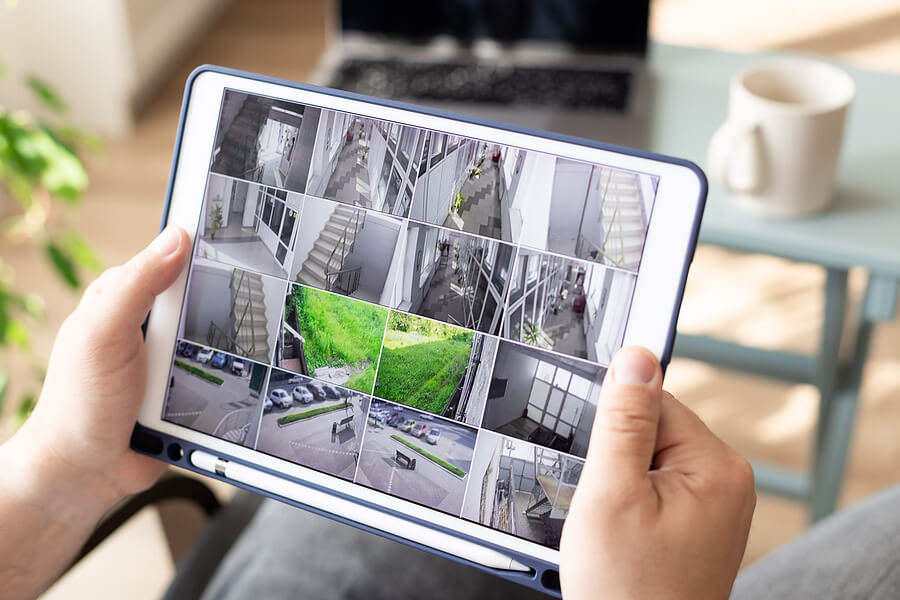Whether you’ve just moved into your first house or you’ve finally put the finishing touches on your dream home, you want your home to be a place you can feel safe and secure in. Thankfully, there are now many options for securing your home available and plenty of ways to make sure you are comfortable and protected. Here are our top 5 tips on securing your home.

Install a Home Security System
One of the most obvious and effective ways of protecting your home and your family is to install a home security system. This might come in the form of something as simple as a motion-activated security light to illuminate the outside of your house, all the way up to a full CCTV system.
Of course, the more protection you are able to install, the better, with experts recommending integrating an alarm system with other tools, such as motion detectors and door/window locks. However, even just having a visible alarm fitted to the exterior of your home will go a long way to deterring would-be trespassers and making your house an unappealing target for thieves.
It goes without saying, but the cost of installing a home security system will vary greatly depending on what options you choose. It may not be practicable for everyone to fit an all-singing-all-dancing CCTV and alarm system, but as we said above, anything is better than nothing.
A more affordable option to consider is purchasing a video doorbell. There are a range of popular brands to choose from, many of which are available for under $100. With one of these doorbells, you are able to see who it is that’s banging on the door and whether you want to answer. This can be reassuring to know, especially if you are home alone. A lot of video doorbells also come with motion-activated video recording, which will record a short clip when movement is detected outside your door that can then be viewed by you. This lets you see if anyone has been snooping around your house when you are not in or in the middle of the night. Or, you might just catch a glimpse of the neighborhood cat!
Store Spare Keys in a Secure Location
We’ve all done it – left a spare key under the mat or behind a plant pot so the kids can let themselves in when they get home from school, or for when your husband accidentally locks himself out… again! It’s a convenient way to make sure you always have access to your home in a pinch, but it also provides a potential entry route for intruders. One lift of the mat and they can stroll right in.
A key safe provides a secure, inexpensive place to house your spare keys. A small box with a combination code, most brands can be affixed to the outside of your home, meaning they can’t be removed. They are also durable and sturdy, so they can’t be prized open using tools such as saws and drills. All you have to do is pop your spare key inside, and make sure whoever you want to have access is given the combination code.
Install a Gate and Fence
A large part of home security is making your house seem more trouble than it’s worth. A well-maintained gate and fence encircling your property can go a long way in deterring someone from trying their luck and sidling right up to your front door.
As with all of these options, anything is better than nothing, but a sturdy fence and a thick gate with a lock would be preferable. It is important to ensure that the gate is the same height as the fence – it won’t do much good if someone can just step right over!
Another thing to consider is lining your yard with dense, thorny plants. It may not seem like a lot, but a row of thick, prickly shrubbery might just make someone think twice about hopping over your fence.
Lock Up Outdoor Furniture
It is lovely to find some outdoor furniture that can sit out on the deck come rain or shine. It is less lovely to wake up one morning and find it has been swiped! If possible, outdoor furniture should always be locked away in a secure outbuilding, such as a shed or garage. If this isn’t possible, perhaps look into a way of securing your furniture in place by directly bolting it to the ground or using anchor points.
This also applies for other things that are routinely left outside, such as bikes and barbeques. Always make sure that these are locked away somewhere out of sight and out of reach.
Protect Your Family’s Data
Something that is often overlooked when thinking about home security is the security of your personal data. In the age of ‘smart homes’, it seems that every appliance is connected to the internet, from TVs to toasters. While it is likely that your Wi-Fi router already has a password set up (although this is worth checking) to prevent just anyone from gaining access to your network, there may be many other devices in your home that are not secure. Each of these presents a point of entry for bad actors, who may be able to access your personal data.
Ensure that all devices in your home are password-protected, and in the case of those that transfer sensitive information, the data is encrypted. It is also important to ensure you have up-to-date and robust anti-virus protection on your computers and laptops to prevent the installation of unwanted programs or the harvesting of your data by outside sources.


